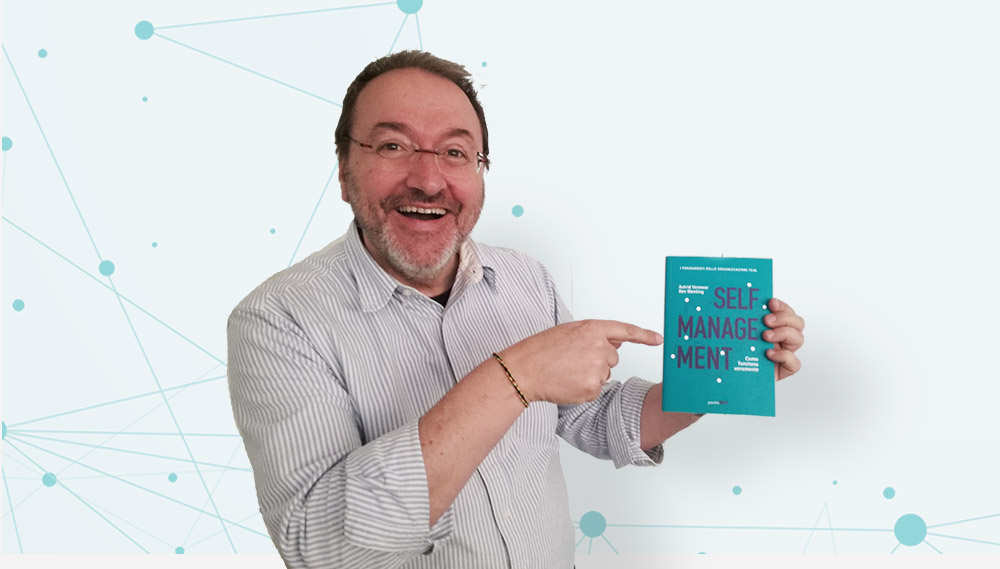Alessandro Rossi and I came across “Self-Management” more or less by chance. We were looking for a book that would define in practical and contextual terms the Teal paradigm, which Peoplerise references in its projects for change management. Just as we were leaving after one of our many visits to Buurtzorg – the Dutch company where there are no bosses but only self-managing teams – the founder Jos de Blok gave us this book, describing it as one of their on-boarding texts, used internally for people coming into the firm. When we got on the plane we started reading it, and we devoured it. We couldn’t stop underlining bits and discussing them.

It’s a book for people who live for their firm, for anyone who makes up an organisation, both bosses and staff. It uses incredibly simple language and gives extremely clear examples. It provides numerous incentives to adopt the Teal practices suggested, but it doesn’t presume to tell you “this is Gospel”. It makes you want to adopt the incentives described in page after page to ideas you’re considering or which are already being implemented in your firm, perhaps making them simpler. At other times while you’re reading it you say to yourself “Wow, I hadn’t thought of that, if I adopt this measure I could make my life simpler”.
NOT JUST SELF-ORGANISATION BUT ALSO PURPOSE AND WHOLENESS
The text also gives a whole series of advice which shows you that this approach is not purely about organisation; it’s also essential to consider the other two fundamental ingredients – purpose and wholeness, in order to move towards a more eco-systemic organisational paradigm based on genuine relationships, a deep-rooted sense of community and a meaningful goal. It’s as if it’s saying “dear firm, the paradigm can only be changed from deep within, not by merely adopting practices”. And here there’s a really interesting balancing between not wanting to trivialise the essentials of the approach and at the same time the desire to provide simple prompts for the people who make up the firm.
Indeed, in the preface to the book, Buurtzorg founder Jos de Blok writes: “The authors make it very clear that self-management is not a slogan and that it goes much further than eliminating the various levels of management. Self-organisation and self-management require a different view of people and how they can collaborate on a day-to-day basis in the independent organisation of all the activities that make up their daily work. Excessive checks, procedures, and rules are not compatible with trust in people who want to do their job in the best possible way. This book highlights the practical criteria that lie behind the construction of a truly human-centred organisation. Ben and Astrid share their vast knowledge and long experience in self-management with the reader in an accessible way, encouraging the practical implementation of the purpose of self-organisation: improved service and more meaningful work.”
A BOOK THAT SYSTEMATISES AN EXPERIENCE AND CREATES PRACTICES FOR EVERY SECTOR
An extremely interesting aspect of “Self-Management” is that it’s not just an account of things done, but also gives ideas for experimentation. It makes you see that change is possible, that it’s more than mere philosophy, because it’s written on the basis of experience, describing what two business consultants did to help an inspired leader put his inspiration into practice in his firm in a very simple way.
FOR THOSE WHO WANT TO TAKE A STEP TOWARDS CHANGE
This book, then, is aimed at anyone who feels intuitively that organisations can change and work in a more horizontal way, geared to customers and their needs.
I imagine that the inspiration comes from Frederic Laloux’s “Reinventing Organisations”, and thus “Self-Management” allows leaders to give their people developmental application. This is a book that can easily be given to staff. When motivated by someone who really inspires us, all of us come up against the fact that while their inspiration resonates with us, in practical terms we’re clumsy in actually taking the step, because we lack the basics. And here’s a book which, with a good leader behind it, gives you the basics.
SOLVING PROBLEMS BY LOOKING AT THE FUTURE
“Self-Management” also introduces an important concrete proposal concerning problem-solving. It’s called the Solution Driven Method and basically it’s this: when looking for new solutions, people tend to look backwards and cling to what hasn’t worked in the past. In a process where there’s no boss leading, but a team in charge, this can result in conflict and dissatisfaction. The Solution Driven Method leads us to focus on the problem and its solution; instead of focusing on the past and dealing with reality, it allows us to observe reality and engage with the future.
Moving time by a click. We can imagine that there’s a little key that moves us around on a calendar. Working in problems and difficulties means moving the key from the present to the past, while using the Solution Driven Method means looking from the present to what’s to come. In other words, working today for the future, rather than looking solely at what’s already happened.
In fact, if I consider a problem and look behind me to imagine how I might solve it, I’ll always be inside something that didn’t work. And this generates a series of frustrations. Then, through a series of continuous loops, I might come up with solutions, but they’re always limited and fall short. But if I change my perspective and look to the present and what I need, or consider the problem I need to solve using the past only as an initial reference point, my approach to problem-solving is transformed.
INNOVATIVE IN ITS PRACTICALITY
“Self-Management” is a guide which makes it possible to build a firm in which there are bosses as we know them, and the real driver is the customer. This is the innovative aspect of the book. It describes a philosophy implemented by one company and makes it inspirational for many others.

